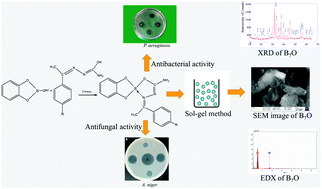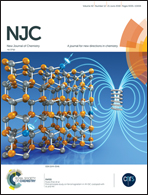Some boron compounds of semicarbazones: antimicrobial activity and precursor for the sol–gel transformation to nanosized boron oxide
Abstract
Few new boron derivatives of the type [(4-C6H4R)C(CH3)N![[upper bond 1 start]](https://www.rsc.org/images/entities/char_e010.gif) N:C(NH2)O
N:C(NH2)O![[upper bond 1 end]](https://www.rsc.org/images/entities/char_e011.gif)
![[lower bond 1 start]](https://www.rsc.org/images/entities/char_e012.gif) B(OC6H4O
B(OC6H4O![[lower bond 1 end]](https://www.rsc.org/images/entities/char_e013.gif) )] were synthesized by the reaction of O
)] were synthesized by the reaction of O![[upper bond 1 start]](https://www.rsc.org/images/entities/char_e010.gif) C6H4OB
C6H4OB![[upper bond 1 end]](https://www.rsc.org/images/entities/char_e011.gif) OPri and LH [LH = (OH)C(NH2)NN:C(CH3)(4-C6H4R)], [where R = H(L1H); CH3(L2H); OCH3(L3H); Cl(L4H); Br(L5H)] in a 1 : 1 molar ratio under toluene reflux. All these newly synthesized complexes were characterized using elemental analysis, and their probable structures were proposed on the basis of IR, 1H, 13C and 11B spectral data and EI mass spectrometry. Antimicrobial activities of the semicarbazone ligands and their boron derivatives were investigated against E. coli and P. aeruginosa bacteria and A. niger and P. peniculosum fungi. B(OPri)3 and the boron semicarbazone derivative [(4-C6H4Cl)C(CH3)N
OPri and LH [LH = (OH)C(NH2)NN:C(CH3)(4-C6H4R)], [where R = H(L1H); CH3(L2H); OCH3(L3H); Cl(L4H); Br(L5H)] in a 1 : 1 molar ratio under toluene reflux. All these newly synthesized complexes were characterized using elemental analysis, and their probable structures were proposed on the basis of IR, 1H, 13C and 11B spectral data and EI mass spectrometry. Antimicrobial activities of the semicarbazone ligands and their boron derivatives were investigated against E. coli and P. aeruginosa bacteria and A. niger and P. peniculosum fungi. B(OPri)3 and the boron semicarbazone derivative [(4-C6H4Cl)C(CH3)N![[upper bond 1 start]](https://www.rsc.org/images/entities/char_e010.gif) N:C(NH2)OB
N:C(NH2)OB![[upper bond 1 end]](https://www.rsc.org/images/entities/char_e011.gif)
![[lower bond 1 start]](https://www.rsc.org/images/entities/char_e012.gif) (OC6H4O
(OC6H4O![[lower bond 1 end]](https://www.rsc.org/images/entities/char_e013.gif) )] were used as precursors to synthesize nanosized cubic B2O3 (A and B) and orthorhombic B7O (C), respectively, by sol–gel transformation. The average particle sizes of B2O3 (A) and (B) and B7O (C) are ∼9.41 nm, ∼14.87 and ∼16.81 nm, respectively.
)] were used as precursors to synthesize nanosized cubic B2O3 (A and B) and orthorhombic B7O (C), respectively, by sol–gel transformation. The average particle sizes of B2O3 (A) and (B) and B7O (C) are ∼9.41 nm, ∼14.87 and ∼16.81 nm, respectively.



 Please wait while we load your content...
Please wait while we load your content...